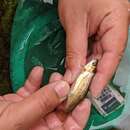Diagnostic Description
provided by Fishbase
Diagnosis: Lateral line scales (43)45-49(51); above lateral line (9.5)10-11(10.5); right pharyngeal teeth 5-6 (Ref. 55426). Differs from its congeners by having eye diameter greater than snout length, usually 43-47 + 2-3 scales on lateral line and 3½-5 scale rows between lateral line and pelvic origin (Ref. 59043).Description: Body relatively narrow, moderately laterally compressed body with rounded abdomen. Head relatively small, with length 20.54-25.28% in standard length; head depth about 1.6 times greater than caudal peduncle depth. Eyes are small and with inferior arched mouth, without a conspicuous horny blade on lower lip. Dorsal and anal fins similar in size, generally with 7 branched rays in dorsal and 7 or 8 in anal, both with slightly convex profile; origin of dorsal fin located above end of pelvic fins or slightly posterior to this; caudal fin with slightly rounded lobes. Scales numerous and of medium-size, with distinct and complete lateral line; small and numerous gill rakers, along entire gill arch; 6/5 or 6/6 smooth and knife-shaped pharyngeal teeth, in one row (Ref. 55426).
- Recorder
- Estelita Emily Capuli
Life Cycle
provided by Fishbase
Forms large spawning aggregations. A female spawns with one or a few males, which press the female against the substratum and eggs are released. These movements attract other individuals to start spawning. The aggregations disperse after about 20-60 seconds and many form again several times. Deposits adhesive eggs (Ref. 59043).
Morphology
provided by Fishbase
Dorsal spines (total): 3; Dorsal soft rays (total): 6 - 8; Analspines: 3; Analsoft rays: 6 - 8
- Recorder
- Estelita Emily Capuli
Biology
provided by Fishbase
Found in coastal rivers and terminal segments of main rivers (Ref. 26100). Occurs in middle and lower reaches of streams, with slow current and underwater vegetation. Forms large spawning aggregations (Ref. 59043). Threatened due to habitat destruction (Ref. 26100).
Iberochondrostoma lusitanicum: Brief Summary
provided by wikipedia EN
Iberochondrostoma lusitanicum, or the boga-portuguesa (its common names in English and Portuguese are the same), is a species of freshwater fish in the family Cyprinidae. It is found only in a very restricted area in Portugal, and is threatened by pollution and habitat destruction (dams).
Iberochondrostoma lusitanicum live in coastal rivers and terminal segments of main rivers, and reach a maximum length of about 15 cm (5.9 in) TL.
- license
- cc-by-sa-3.0
- copyright
- Wikipedia authors and editors

